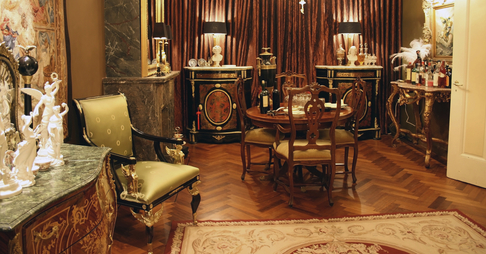Interior Design Styles

Baroque (Rococo)
When you think of luxurious or over-the-top ornamental home décor, Baroque style typically comes to mind. This style was adopted by European royalty in the seventeenth century and was the preference of palaces and churches throughout Europe through the mid-eighteenth century (Louis XIV’s palace at Versailles is done in a Baroque style). The Baroque color palette is often rich, incorporating dark reds or greens to enhance gold accent features that are commonly used to decorate mirrors, art, and accessories. Baroque interiors are highly detailed, including intricately carved wood detailing paired with luxurious textiles used for furniture, wall, and window coverings. These fabrics are often damask or floral patterned. In the early eighteenth century, Rococo evolved from the Baroque style, keeping the opulent design elements, but adopting a pastel color palette and taking itself less seriously with whimsical art.
Elements of design
- Characterized as dramatic, opulent, and luxurious with rich colors, intricately designed furniture, gilded and ornamental accessories, and high-end textiles
- Floors are typically made from high-end materials such as solid wood or marble
- Large room-sized, hand-woven rugs are placed to soften spaces
- Furniture is intricately detailed to accent embellishments with curved legs, carved details, and gilding
- Gold frames and gilding on statues and pottery are common
- Large mirrors, crystal chandeliers, door knobs, and pulls are commonly used
- Luxury fabrics in damask and floral prints are used for upholstery, wall coverings, and floor-to-ceiling window coverings
- Rococo is a lighter, more whimsical version of the Baroque style, using a pastel palette and light-hearted art
Share


